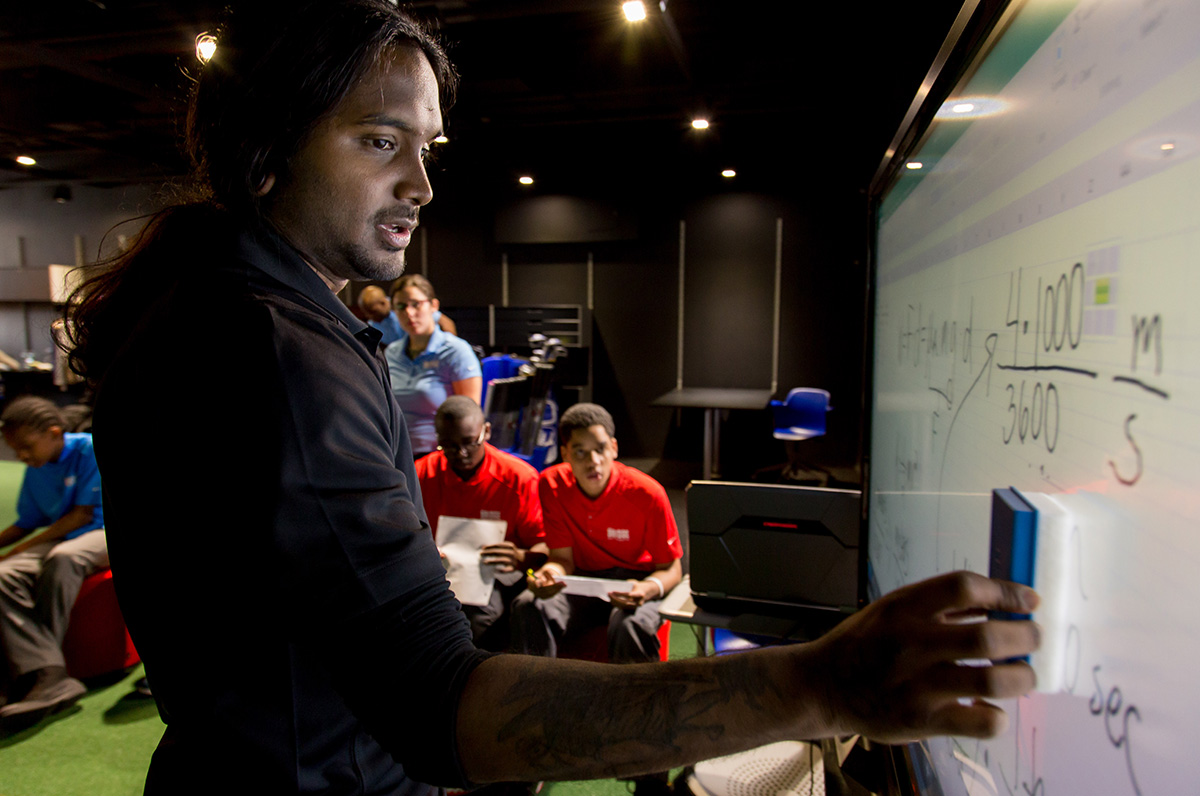
Veeshan Narinesingh, a native of the Bronx, is the STEM Program Co-Leader at The Bridge Golf Foundation and a Ph.D. student in physics at the CUNY Graduate Center. He recently fielded some questions from Executive Director and Co-Founder Farrell Evans.
FE: How did you develop a love for physics?
VS: When I was a kid (and even now), I used to stare into the night sky a lot. All those stars and worlds out there, I wanted to visit them all. I learned about crazy things like blackholes and supernovae. I wanted to understand them, but I needed to understand everything else first.
FE: How has your experience as a young man of color from New York influenced your teaching and relationships with our young men?
VS: I see myself in a lot of them. I see young men who genuinely care about this world and want to make a difference in it. I see hungry minds, wanting to learn, but also faces wanting to smile and enjoy life.
I have gone through what they are going through. I can remember back to when I was in their position, what worked, what didn’t. I think back to what techniques and activities really made me understand, and what ingrained lessons into my head.
FE: As STEM Program Leader, you have been very successful in getting your City College physics department colleagues involved in our STEM program. How important has that partnership been to the success of the STEM program?
VS: I’ve been fortunate to have made good friends who share my passions, amazing people who seek to understand how the universe works and share that knowledge with others.
We have been able to devise some really cool, interactive lessons with faculty and students from the college. I am thankful to everyone who has been involved
Much of our Foundation staff has also been associated with the college. The success of our program attests to the quality that our public institutions can produce for those willing to work hard. Many of us also have strong ties to New York. It enables a greater connection with our students.
FE: Tell us about your Ph.D. program in physics at the CUNY Graduate Center and your research.
VS: I’ve been granted an almost unreal opportunity. I get to learn about what I love! It’s been very tough, but also a welcome challenge. Being back in the classroom myself has deepened my understanding and improved my ability to explain pretty much all of the physics and math we do at the Foundation.
At the moment, I am a bit undecided on a research direction. Through much of my earlier career, I worked in an optics lab performing experiments with lasers, and characterizing materials. I also spent some time researching solar devices, with the aim of enhancing their efficiency.
Experimental physics was very interesting, and I acquired a lot of skills, but I have so much more to learn and would like to try my hand in theoretical work. Solid state systems and how their electrons behave under different circumstances has really been on my mind lately.
FE: You didn’t know much about golf before joining our Foundation. How has your physics background helped you understand the game?
VS: Golf is pretty much applied physics. To me, it’s a real-life version of a lot of the things I learned about in school.
When I see the ball being struck with different lofts, I know we are changing the scattering angle.
When you tell me about fast or slow greens, I’m thinking about rolling friction and dissipative forces.
It’s very intuitive.
FE: We’re preparing our young men to be competitive in a workplace that is increasingly dominated by careers in science, technology, engineering and math through a lot of hands-on experience with various technologies in the Learning Center. Why is it so important for the young men to perform projects and get hands-on experience in the STEM Lab?
VS: There is this really good saying: “Tell me and I forget, show me and I may remember, involve me and I understand.”
One does not acquire skill without practice. The work our young men do in the lab puts them in a broad set of scenarios. They do not just learn physics and golf. They learn coding, animation, teamwork, planning, public speaking, data collection — the list continues.
Versatility and adaptivity are essential tools for the problem solvers and thinkers of tomorrow.
FE: What are your hopes and dreams for the young men in the program?
VS: Success.
I want them to go out there and do cool, productive things in this world. To learn, to teach. I want them to lead. I want them to invent. I want them to be happy and to help people.
Given their determination and the opportunities available to them, I am sure they will do just that.